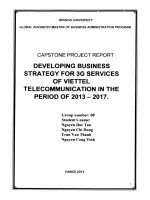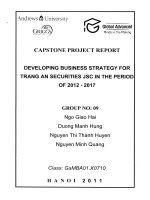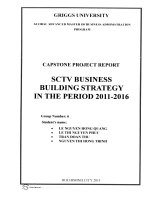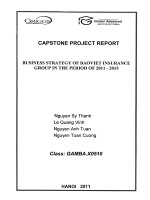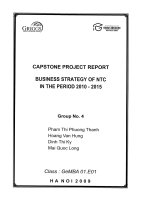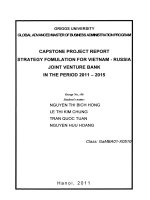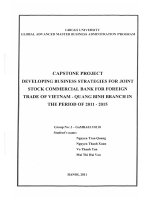ROLE OF STATE IN THE DEVELOPMENT OF VIETNAM’S AUTOMOBILE INDUSTRY FOR THE PERIOD 2011 - 2020
Bạn đang xem bản rút gọn của tài liệu. Xem và tải ngay bản đầy đủ của tài liệu tại đây (330.58 KB, 47 trang )
SOLVAY-BRUSSELS SCHOOL OF
ECONOMICS AND MANAGEMENT
NATIONAL ECONOMICS UNIVERSITY
Vietnam – Belgium Master Programs
MASTERS IN PUBLIC MANAGEMENT AND ECONOMICS
FINAL PROJECT
ROLE OF STATE IN THE DEVELOPMENT OF VIETNAM’S AUTOMOBILE
INDUSTRY FOR THE PERIOD 2011 - 2020
Prepared by: Hoa Ngoc Tu
Supervisor: Do Thi Hai Ha PhD
Hanoi 2011
ACKNOWLEDGEMENT
I would like to express my gratitude to all those who gave me the possibility to
complete this thesis.
I deeply indebted to my supervisor Dr. Do Thi Hai Ha, from National
Economic University, whose help, stimulating suggestions and encouragement helped
me in all the time of research for and writing of this thesis.
I
would like
to sincerely thank to the Ministry of Industry and Trade for
their kind support to help
me accomplish
this thesis
. The officials of this ministry
has shown their great assistance in
providing me with the effective data.
I am profoundly grateful to Prof. Daniel Van Houtte
, Dr. Nguyen Thi Thanh
Huong and many other professors
of the Master course for their interesting and
insightful lectures
.
Especially, I would like to give my special thanks to my father – in –law, my
wife and my daughters who were so kind to be by me all the time, helping me to
complete this final project as well as all of my Master course.
Ha noi, 24 March 2011
Hoa Ngoc Tu.
1
TABLE OF CONTENTS
LIST OF ABBREVIATIONS 4
ASEAN: The Association of Southeast Asian Nations 4
CP: Government 4
GDP: Gross Domestic Product 4
R&D: Research and Development 4
SUV: Sport Utility Vehicle 4
VAMA: Vietnam Automobile Manufacturer Association 4
WTO: World Trade Organization 4
2.5: Engine capacity of 2.5 liter 4
LIST OF TABLES & FIGURES 5
Chapter 1. INTRODUCTION 7
1.1. RATIONALE 7
1.2. RESEARCH OBJECTIVES PROBLEMS 8
1.3RESEARCH OBJECTIVES 8
1.43. RESEARCH METHODOLOGY 8
1.43.1. Research methods 8
1.54. SCOPE OF RESEARCH 12
1.5. PROJECT STRUCTURE 13
Chapter 2. OVERVIEW OF VIETNAM’S AUTOMOBILE INDUSTRY 14
2.1 THE FORMATION AND DEVELOPMENT OF VIETNAM’S AUTOMOBILE
INDUSTRY 14
2.1.1 Development of car assembly joint venture enterprises 14
2.1.2 Development of domestic automobile manufacture/assembly enterprises 17
2.1.3 Vietnam’s domestic automobile market 18
2.2. CONTRIBUTION OF VIETNAM’S AUTOMOBILE INDUSTRY 19
2.2.1. Contribution to economic development through investment 19
2.2.2. Contribution to state budget 20
2.2.3 Creating jobs 21
2.2.4 Technology transfer 21
2.3 FACTORS AFFECTING THE DEVELOPMENT OF VIETNAM’S
AUTOMOBILE INDUSTRY 21
2.3.1 Internal factors 22
2.3.2 External factors 23
Chapter 3: ROLE OF STATE IN THE DEVELOPMENT OF VIETNAM’S
AUTOMOBILE INDUSTRY 26
3.1 STATE’S ORIENTATION ON THE DEVELOPMENT OF VIETNAM’S
AUTOMOBILE INDUSTRY 26
3.2 STATE’S REGULATIONS ON THE DEVELOPMENT OF VIETNAM’S
AUTOMOBILE INDUSTRY 27
3.2.13. INCENTIVE POLICIES 28
3.4. SUPERVISION ON REGISTRATION AND QUALITY CONTROL 28
2
3.2.24.15 Ggovernment apparatus: bo xung them vai tro cac bo: Cthuong, CA,
GTVT. 28
3.4.2. aAssessment of coordination among government apparatus 31
3.356 OVERALL ASSESSMENT OF STATE’S REGULATIONS ON THE
DEVELOPMENT OF VIETNAM’S AUTOMOBILE INDUSTRY 31
3.356.1 Achievement 31
3.563.2 Shortcomings 32
3.356.3 Reasons for shortcomings 33
Chapter 4: 35
RECOMMENDATIONS FOR IMPROVING STATE’S REGULATION 35
ON THE DEVELOPMENT OF VIETNAM’S AUTOMOBILE INDUSTRY FOR
THE PERIOD 2011 – 2020 35
4.1 FORECASTING THE TREND OF DEVELOPMENT OF VIETNAM’S
AUTOMOBILE INDUSTRY IN THE PERIOD 2011-2020 35
4.1.1 Three main trend for global automobile industry: 35
4.1.2 Development orientation by Government government in other country
countries for development of automobile industry 36
4.2 Development orientation for Vietnam’s automobile industry 37
4.3 RECOMMENDATIONS FOR IMPROVING STATE’S REGULATION ON
THE DEVELOPMENT OF VIETNAM’S AUTOMOBILE INDUSTRY FOR THE
PERIOD 2011 – 2020 38
3
LIST OF ABBREVIATIONS
ASEAN: The Association of Southeast Asian Nations
CP: Government
GDP: Gross Domestic Product
R&D: Research and Development
SUV: Sport Utility Vehicle
VAMA: Vietnam Automobile Manufacturer Association
WTO: World Trade Organization
2.5: Engine capacity of 2.5 liter
4
LIST OF TABLES & FIGURES
LIST OF ABBREVIATIONS 4
ASEAN: The Association of Southeast Asian Nations 4
CP: Government 4
GDP: Gross Domestic Product 4
R&D: Research and Development 4
SUV: Sport Utility Vehicle 4
VAMA: Vietnam Automobile Manufacturer Association 4
WTO: World Trade Organization 4
2.5: Engine capacity of 2.5 liter 4
LIST OF TABLES & FIGURES 5
Chapter 1. INTRODUCTION 7
1.1. RATIONALE 7
1.2. RESEARCH OBJECTIVES PROBLEMS 8
1.3RESEARCH OBJECTIVES 8
1.43. RESEARCH METHODOLOGY 8
1.43.1. Research methods 8
1.54. SCOPE OF RESEARCH 12
1.5. PROJECT STRUCTURE 13
Chapter 2. OVERVIEW OF VIETNAM’S AUTOMOBILE INDUSTRY 14
2.1 THE FORMATION AND DEVELOPMENT OF VIETNAM’S AUTOMOBILE
INDUSTRY 14
2.1.1 Development of car assembly joint venture enterprises 14
2.1.2 Development of domestic automobile manufacture/assembly enterprises 17
2.1.3 Vietnam’s domestic automobile market 18
2.2. CONTRIBUTION OF VIETNAM’S AUTOMOBILE INDUSTRY 19
2.2.1. Contribution to economic development through investment 19
2.2.2. Contribution to state budget 20
2.2.3 Creating jobs 21
2.2.4 Technology transfer 21
2.3 FACTORS AFFECTING THE DEVELOPMENT OF VIETNAM’S
AUTOMOBILE INDUSTRY 21
2.3.1 Internal factors 22
2.3.2 External factors 23
Chapter 3: ROLE OF STATE IN THE DEVELOPMENT OF VIETNAM’S
AUTOMOBILE INDUSTRY 26
3.1 STATE’S ORIENTATION ON THE DEVELOPMENT OF VIETNAM’S
AUTOMOBILE INDUSTRY 26
3.2 STATE’S REGULATIONS ON THE DEVELOPMENT OF VIETNAM’S
AUTOMOBILE INDUSTRY 27
5
3.2.13. INCENTIVE POLICIES 28
3.4. SUPERVISION ON REGISTRATION AND QUALITY CONTROL 28
3.2.24.15 Ggovernment apparatus: bo xung them vai tro cac bo: Cthuong, CA,
GTVT. 28
3.4.2. aAssessment of coordination among government apparatus 31
3.356 OVERALL ASSESSMENT OF STATE’S REGULATIONS ON THE
DEVELOPMENT OF VIETNAM’S AUTOMOBILE INDUSTRY 31
3.356.1 Achievement 31
3.563.2 Shortcomings 32
3.356.3 Reasons for shortcomings 33
Chapter 4: 35
RECOMMENDATIONS FOR IMPROVING STATE’S REGULATION 35
ON THE DEVELOPMENT OF VIETNAM’S AUTOMOBILE INDUSTRY FOR
THE PERIOD 2011 – 2020 35
4.1 FORECASTING THE TREND OF DEVELOPMENT OF VIETNAM’S
AUTOMOBILE INDUSTRY IN THE PERIOD 2011-2020 35
4.1.1 Three main trend for global automobile industry: 35
4.1.2 Development orientation by Government government in other country
countries for development of automobile industry 36
4.2 Development orientation for Vietnam’s automobile industry 37
4.3 RECOMMENDATIONS FOR IMPROVING STATE’S REGULATION ON
THE DEVELOPMENT OF VIETNAM’S AUTOMOBILE INDUSTRY FOR THE
PERIOD 2011 – 2020 38
6
Chapter 1. INTRODUCTION
1.1. RATIONALE
According to Decision No. 177/2004/QD-TTg dated October 05th, 2004,
promulgated by The Prime Minister, approving the planning on development of
Vietnam’s automobile industry till 2010, with a vision to 2020, Vietnam has to achieve
the goal of developing Vietnam’s automobile industry by acquiring and applying
world’s advanced technologies. By exploiting and gradually improving existing
technologies and equipment, Vietnam’s automobile industry, at first, has to meet most
of the requirements of domestic automobile market, and then, moving toward exporting
automobile and accessory. Specific goals need to be achieved:
- Popular automobiles: meet 40-50% of the domestic demand in terms of quantity
and get a localization rate of 40% by 2005; meet above 80% of the domestic demand in
terms of quantity and get a localization rate of 60% by 2010 (For engines, the
localization rate shall reach 50% by 2010, and for gearbox, it shall reach 90% by 2010).
- For special-use automobiles: meet 30% of the domestic demand in terms of
quantity and get a localization rate of 40% by 2005; meet 60% of the domestic demand
in terms of quantity and get a localization rate of 60% by 2010.
- For high-class automobiles: Tourist cars manufactured by joint ventures must
reach the localization rate of 20-25% by 2005, and 40-45% by 2010. For high-class
buses, the localization rate shall reach 20% by 2005 and 35- 40% by 2010, meeting 80%
of the domestic requirement.
Although specific goals were set, almost all of the goals have not been met till
now. For instance localization rate just reaches 12% and the prices are too high
compared to the income of Vietnamese. It could probably be caused by many different
reasons, among of which the main reason is we did not foresee the difficulties and
complexity of automobile industry. For example, Thailand, a leading country in East
Asia in automobile manufacture with production of 1.2 million vehicles/year, does not
have its own brand name cars. It does not mean that Thailand automobile industry is
underdeveloped because it has 700 car components manufactures and 1000 auxiliary
manufacturers, turning Thailand into a reliable supplier to most of car manufacturers in
the world.
In China, automobile industry has been developed for 30 years and protected by
the government. Till now, there are just few so-called “big manufacturers” out of 2500
car manufacturers and car components manufacturers in China. Annual turnover of
China’s Automobile Industry is lower than car sales of a medium-sized car
manufacturer in Japan, USA or Europe.
In India, the first car appeared in 1898. Since then, India has attached special
importance to development of automobile industry. However, due to its economic
characteristics, cars manufactured in India serve middle class or lower classes only.
7
India automobile industry is more and more developing and becomes a “power” in
automobile industry worldwide. India is now the second biggest motorcycle
manufacturer in the world; ranks 11
th
in manufacturing tourist cars and ranks 13
th
in
manufacturing commercial cars. India is now an ideal destination for many big
manufacturers in the world and realizes its ambitions to be a leading center for
automobile manufacturing in 2016 with “Action Plan of Motors”. Its goal is to reach
production of 32 million vehicles in period of 2015-2016 with total investment of 35-40
billion US dollars.
Above analyses help to produce the judgment that it takes many years to develop
our automobile industry, depending on the development of our economy and on related
industries. Therefore, it is necessary to analyze development ability of Vietnam’s
automobile industry based on its current status, requirements and ability to satisfy the
requirements.
1.2. RESEARCH OBJECTIVES PROBLEMS
The objectives of the project is to access the role of Vietnam’s Government in the
development of Vietnam’s automobile industry, then propose comprehensive
Government’s solution to develop Vietnam Automobile Industry for the period of 2011-
2020. This project focuses on indentifying the following issues: To get the goals set for
the period of 2011-2020, some research problems to be implemented are as follows:
1. Current status of Vietnam’s Automobile automobile Industryindustry;
2. Requirements forFactors affecting the development of developing automobile
industry; and
3. Government’s role in developing automobile industry Ability to satisfy the
requirements.
1.3RESEARCH OBJECTIVES
Proposing comprehensive solution to develop Vietnam Automobile Industry for
the period of 2011-2020.
1.43. RESEARCH METHODOLOGY
1.43.1. Research methods
In order to analyse the existing problems of Vietnamese automobile industry and
the current role of Vietnamese government in supporting the industry, as well as to
make recommendation for a better government role in supporting the industry, the
following approaches are undertaken: (i) SWOT anlysis where strengths, weaknesses,
opportunities and threats to Vietnamese automobile industry are analysed; and (ii)
knowledge and approaches learnt from the classes on Role of State in a Market
Economy which was lectured by Prof Daniel Van Houte;
Throughout this thesis, the roles played by the following actors and the
interactivity of these actors will be analysed carefully.
8
The approaches undertaken have helped identify the following findings:
1.4.23.1.1. Actors involving in the Vietnamese automobile industry
Government: The government has played a significant role in Vietnamese
automobile industry. Through the tax policies, protectionism policies, environment
rules, liberalisation of automobile sector (under its FTA negotiations) and infrastructure
development, the ministries and agencies of Vietnamese government has created
substantial influence on the industry.
Domestic car makers: The domestic car makers comprises mainly two groups.
They are joint venture companies between a Vietnamese partner and a FDI enterprise.
These joint ventures companies in fact mainly assembled cars based on the supplies of
car parts imported into Vietnam.
Cars importers: They include two main groups as follows: importers of
Completely Built Units (CBU vehicles - - brand new cars), and importers of used cars.
Currently, the car importers operating in Vietnam are mainly Vietnamese trading
companies, but there is a tendency showing that some domestic car makers are
expanding their business to importing CBU.
9
GOVERNMENT
Minitry of Industry & Trade;
Ministry of Finance;
Ministry of Transport;
Ministry of Public Security
CAR MAKERS
Domestic assemling
jointventures;
Cars importers;
Association(VAMA)
Accessory industry
CONSUMERS
Association: The Vietnam Automobile Manufacturing Association (VAMA) is
the only one association represeting the car makers and car importers. By the end of
2010, VAMA had eighteen members. This association is having a stronger voice
influencing the government’s policies. Nonetheless, its recommendations about policies
to the government are mainly encouraging protectionism because the VAMA members,
most of them are car makers, enjoy lots of benefits from protectionist policies.
Accessories industry: Vietnam has a very premature accessories industry which
lack capital, advanced technologies, and skilled workers. Most importantly, the
accessories industry of Vietnam fails to create a strong link with car makers, and at the
same time does not have a development strategy for itself.
Consumers: The role of Vietnamese consumers in this respect are evolving rather
quickly. They are moving from preference for cheap used cars to the choice of medium
priced vehicles as their income get improved in the recent years. However, besides the
improving purchase power, Vietnamese consumers have not yet had an influential voice
to protect themselves because of the limited role played by the Vietnamese Consumers
Protection Association.
1.4.33.1.2. Main factors influencing Vietnamese automobile industry:
SWOT analysis, as described briefly in the table below, will go closely with all
details of this thesis. In particular, SWOT is conducted to analyze strengths, weaknesses,
opportunities and threats of Vietnam’s automobile industry. tThe factors reflecting the
environment in whichinfluencing Vietnam’s the automobile industry operates are more
clearly seen through the SWOT analysis.
STRENGTHS
Hardworking and cheap labour;
Strongly commited government;
WEAKNESSES
lack of capital;
backward technology;
inadequate management skills;
under-developped accesory industry;
OPPORTUNITIES
Improving incomes of people;
Huge market of 86 million people;
Potential exports of CBU and car parts
under existing and future FTAs;
THREATS
Inadequately coordinated/ even conflicting
government policies;
Substantial tariff cuts for CBU and car
parts under Vietnam’s international trade
liberalisation commitments (WTO, CEPT,
BTA, VJEPA)
10
Key factors affecting the development of Vietnam’s automobile industry are:
Government direct policies: The policies enacted by the government of Vietnam
create the strongest direct and indirect influence on the situation of the automobile
industry. Strong protectionist policies on tariffs, mostly seen before 2007, the year when
Vietnam officially joined the World Trade Organisation, and particularly before 2000
induced the establishment of many domestic car makers. Meanwhile, the trade
liberalisation policy of the government, which commenced with Vietnam’s WTO
membership in January 2007 and intensified with the signing of several FTAs (CEPT
with China and ASEAN, Vietnam-Japan FTA, FTA between Vietnam and Australia-
New Zealand…), has resulted in the growing number of trading companies operating in
cars importation.
Government indirect policies: The indirect policies of the government such as
stimulus measures applied by the government in 2009 and 2010 have shown significant
increase in the purchase of cars. At the same time, pending policy on environment tax
(which is under the discussion of the National Assembly in a draft Law on
Environment) is believed to create discouragement to car users. The government’s
investment in construction of roads a bridges are certainly influencing the consumers’
decision on buying cars.
Technology and capital availability: This factor depends a lot on foreign
investors. In fact, most of the technologies currently used by domestic car joint ventures
are not advanced. Model of cars assembled in Vietnam are often two years later than
those made in foreign countries. Regarding capital source, Vietnamese car assembling
joint ventures depend a lot on foreign partners with as much as 70% of the capital
contributed by foreign partners. The under-developed accessories industry of Vietnam,
which lacks both capital and technologies, is strong evidence for the weakness of the
automobile industry in this respect.
Consumers’ habits and income: Vietnamese consumers’ income is improving
quickly from a GDP per capita worth USD331 in 1996 to more than USD1156 in 2009.
As a result, more and more Vietnamese people can afford a car. Importantly, because
the number of people having cars in Vietnam presently is relatively low, thus the
potential of this market is huge. The consumers’ habit has similar importance on
business decisions of car makers and importers.
To determine the appropriate role of the government in developing the automobile
industry of Vietnam, the above factors should be taken into full consideration.
1.43.4 1.3 Assessment of role of the government:
The gGovernment’s decision on supporting the development of Vietnam’s
automobile is legitimate and right given the important source of tax collection, jobs
11
creation, and the industrialisation and motorisation targets. However, the policies taken
by the government are not well-coordinated and not visional. The policies are even
conflicting and keep changing during different periods of time which are demonstrated
through the changing import tariffs, special consumption taxes, and changing
orientation of priortised types of vehicles. Now time does not support the government of
Vietnam especially since Vietnam signed a number of FTAs with foreign partners, in
which bound rates for CBU cars of below 9 seaters are foreseen to be 60% in 2013 to
0% in 2018 under the CEPT.
The government is now facing a big question: (i) continuing its support to
domestic car makers, so that Vietnam may have a car brand Made in Vietnam in future;
(ii) and/or developing a strong accessories industry to become part of the regional
supply chain of car parts. It is crucially important to have a secure and visional answer
to this question sooner rather than later. The analysis, as presented later in this thesis,
has proved that the policies taken by the government of Vietnam so far are inconsistent
and partially unsuccessful.
1.4.53.1.4 Recommendations to improve the current situation:
The government of Vietnam should review the development strategy for
automobile industry in a practical manner and well-connected with its macro
development policies. Priorities should be given to development of accessories industry
where Vietnam can reap considerable benefits from its participation in the regional
supply chain of car parts. At the same time, the government should maintain a
consistent support to two types of vehicles affordable to and mostly used by Vietnamese
people. They are: (i) the first type of car recommended in this thesis is five-seaters
sedan below 1 litre engine. This type of cars is friendly to environment, cheap price, and
not subject to any commitment of FTAs liberalisation; (ii) the second type of vehicles/
cars is bus of 30 seaters, which can be used more efficiently in future given the demand
of public means of transport.
1.3.2. Data collection
The data for this project is collected from two main sources: primary data and
secondary data.
• Primary data is collected through in-depth interview with government officers,
car makers and consumers.
• Secondary data is gathered from official reports, company profile s , website,
annual business reports, magazines, etc.
1.54. SCOPE OF RESEARCH
Research objectives:
Research objectives of this thesis are problems related to Vietnam’s automobile
12
industry including manufacturing sector, supporting industries, sale and import,
supporting policies of the state.
The research focuses on the elements of Vietnam's automobile industry. On the
basis, appropriate and feasible solutions to develop are proposed.
Scope of research:
Time: from the establishment of the first automobile manufacturing joint venture
company (1991) to 2010.
Space: The research focuses mainly on development activities of VAMA’s
members and refers to activities of some other automobile enterprises.
In addition, the research will have study on success of the automobile industries of
Thailand, China and India. The research tries to give a more comprehensive view of the
automobile industry of Vietnam and development orientations for the automobile
industry in Vietnam.
1.5. PROJECT STRUCTURE
The thesis consists of 04 main chapters:
1. Chapter 1: INTRODUCTION
2. Chapter 2: OVERVIEW OF VIETNAM’S AUTOMOBILE INDUSTRY
3. Chapter 3: ROLE OF STATE IN THE DEVELOPMENT OF VIETNAM’S
AUTOMOBILE INDUSTRY
4. Chapter 4: RECOMMENDATIONS FOR IMPROVING STATE’S
REGULATION ON THE DEVELOPMENT OF VIETNAM’S AUTOMOBILE
INDUSTRY FOR THE PERIOD 2011 – 2020
5. Conclusions
13
Chapter 2. OVERVIEW OF VIETNAM’S AUTOMOBILE INDUSTRY
2.1 THE FORMATION AND DEVELOPMENT OF VIETNAM’S AUTOMOBILE
INDUSTRY
To properly assess the formation and development of Vietnam’s automobile
industry, we can start from beginning of the past 1990s.
Before 1990, there were about 38,212 registered cars in Vietnam, including Gat,
Lada, Zil, Volga, Zil, Uaz, Lada, Gat, Peugeot, Ford, Jeep, Paz, etc.
In 1991, many famous car manufacturers in the world such as Ford, Toyota and
Mercedes-Benz participated in automobile joint venture enterprises in Vietnam. In
2003, there were 11 joint venture enterprises in Vietnam with total investment capital of
543,429 million US dollars, total production of 148,900 cars/year and creating jobs for
more than 3,000 employees.
Until now, there are 18 automobile enterprises nationwide joining in Vietnam
Automobile Manufacturer Association (VAMA), not including some other automobile
manufacturers such as 1/5 motor factory, JRD motor factory, Cuu Long motor factory,
etc.
It can be said that the formation of joint venture enterprises which specialize in
manufacturing, assembling cars in Vietnam recognizes Vietnam as a potential
automobile market.
2.1.1 Development of car assembly joint venture enterprises
Table 2.1 Establishment of car assembly joint venture companies in Vietnam
No Car makers/ status of capital Status of Operation
1 Mekong auto company:
- JV between Vietnam, Japan, and
South Korea;
- Operation started in 1992;
- Operation continues;
- Type of Business: car assembling
and CBU import;
2 Vietnam Motor Corporation (VMC):
- JV between Phillipines and Vietnam;
- Operation started in 1992
- Operation continues;
- Type of Business: car assembling;
3 Vietnam - GM Deawoo (VIDAMCO):
- JV between Vietnam and South Korea;
- Operation started in 1996;
- Operation continues;
- Type of business: Car asembling;
14
4 Vina Star Motors Corporation:
JV between Vietnam, Malaysia and
Japan
- Operation started in 1995;
- Operation continues;
- Type of business: Car asembling
and CBU import;
5 Mercedes Benz Vietnam:
JV between Vietnam, Germany,
Singapore
- Operation started in 1996;
- Operation continues;
- Type of business: Car asembling
and CBU import;
6 Daihatsu Vietindo (Vindaco):
JV between Indonesia and Vietnam
- Operation started in 1996;
- Operation stopped in 2006;
- Type of business: Car asembling;
7 Suzuki Vietnam:
JV between Vietnam and Japan
- Operation started in 1995;
- Operation continues;
- Type of business: Car asembling
and CBU import;
8 Ford Vietnam Ltd:
JV between Vietnam and the USA
- Operation started in 1995;
- Operation continues;
- Type of business: Car asembling
and CBU import;
9 Chrysler Vietnam Ltd:
JV between Vietnam and the USA
- Operation started in 1995;
- Operation stopped;
- Type of business: Car asembling;
10 Toyota Vietnam:
JV between Vietnam, Japan and
Singapore
- Operation started in 1995;
- Operation continues;
- Type of business: Car asembling
and CBU import;
11 Isuzu Vietnam:
JV between Vietnam and Japan
- Operation started in 1995;
- Operation continues;
- Type of business: Car asembling
and CBU import;
12 Vietnam – Singapore motor industrial - Operation started in 1996;
15
company:
JV between Vietnam and Singapore
- License withdrawn;
13 Hino Motors Vietnam:
JV between Vietnam and Japan
- Operation started in 1996;
- Operation continues;
- Type of business: Car asembling
and CBU import;
14 Nissan TCM Vietnam Co., Ltd:
JV between Vietnam, Denmark and
Japan
- Operation started in 2008;
- Operation continues;
- Type of business: Car asembling
and CBU import;
15 VINAMOTOR:
100% capital invested by Government
- Operation started in 2003;
- Operation continues;
- Type of business: Car asembling;
16 Vinacomin Motor:
100% capital invested by Government
- Operation started in 1994;
- Operation continues;
- Type of business: Car asembling
and CBU import;
17 VINAXUKI Motor:
100% capital invested by private
companies
- Operation started in 2004
- Operation continues;
- Type of business: Car asembling
and CBU import;
18 Truong Hai Motor:
100% invested by Vietnamese private
companies
- Operation started in 1995;
- Operation continues;
- Type of business: Car asembling
and CBU import;
Source: Ministry of Planning and Investment
We find that most of the world’s leading car manufacturers from three automobile
centers of USA, Europe and Japan are present here in Vietnam. Total investment capital
is over 700 million USD, total legal capital is over 400 million USD and total designed
capacity is about 200,000 cars/year. Joint venture enterprises play a key role in
automobile industry. They turn Vietnam’s Automobile Industry from zero into fulfilling
domestic automobile demand.
16
State-owned enterprises such as Transinco, Veam also contribute to development
of Vietnam’s automobile industry although their contribution is still small. We have
now 52 domestic enterprises involving in assembling vehicles but the production is still
low and the technology is still underdeveloped. Therefore, referring to Vietnam's
automobile industry, most people only talk about the operation of 11 automobile
manufacture/assembly joint-venture enterprises.
On the other hand, production and assembly of automotive joint venture
companies in Vietnam has not shown modernity in automobile manufacturing. A
standard car factory must have at least four basic processes, including stamping,
welding, painting and assembly, whereas the automobile joint ventures in Vietnam
(except for Toyota which has stamping process) have only 3 last processes (welding,
painting and assembly). All these 3 processes do not require high technology, thus not
improve the localization rate of products.
After this period, the joint ventures develop more car styles, pay attention to
importing cars (e.g., Mercedes, Toyota). Besides, there are some motorcycle
manufacturing joint ventures investing in automobile production. They are VMEP and
HONDA. These joint venture companies have created a quite busy automotive market
in our country
2.1.2 Development of domestic automobile manufacture/assembly enterprises
After the appearance of the car manufacturing joint venture enterprises, domestic
automobile factories have gradually formed and developed as Truong Hai, Vinaxuki,
Cuu Long, Veam, etc.
In domestic car assembly enterprises, they focus primarily on light trucks
providing mainly for domestic market and avoiding competition with other brands of
joint venture enterprises such as Truong Hai with Proto, Force; Xuan Kien with
Vinaxuki; Cuu Long with TMT. Afterwards, some domestic factories have begun to
assemble individual cars (sedans) with little-known and low price brands such as Xuan
Kien with Chinese brands, Truong Hai with Kia, Hyundai (Korea) and more recently,
Mazda (Japan).
Overall, the domestic automobile factories are less developed, they only specialize
in car assembly, and they do not have private car brand because of weak financial
resources and automotive technology.
Currently, Vietnam’s automotive industry specializes in assembly only, including
the following types:
- SKD (Semi Knocked Down): cars to be assembled from components, cluster,
imported unconnected details.
- CKD (Completely Knocked Down): is a complete kit needed to assemble a
product. There are two forms of this type: CKD1 and CKD2.
17
- IKD (Inteopally Knocked Down) cars to be assembled from components,
cluster, unconnected details. Unconnected details can be imported or made in Vietnam.
Body and chassis are made in Vietnam.
While some regional countries like Thailand, Indonesia is focusing in depth on the
type of IKD, both 11 automobile joint ventures in Vietnam have recently moved from
simple assembly (SKD) to detailed assembly (CKD) .
2.1.3 Vietnam’s domestic automobile market
In December, 2010, turnover of members of VAMA got 12,485 vehicles, 17%
decrease compared to that of December, 2009. In which, sale of multi-purpose vehicles
fell 19%, cars 21% and commercial vehicles 13%.
Output of entire sales in 2010 reached 112,224 vehicles, 6% decrease over the
same period last year with decrease of commercial vehicles of 4%, cars of 3% and
multipurpose vehicles of 13%. (See summary table below).
Table 2.2 The sale of cars of VAMA’s members in 2010
North Central South Total
Car 2,336 488 1,249 4,073
Cross-over cars - - - -
MPV cars 468 150 700 1,318
SUV cars 607 206 859 1,672
Minibus, Bus 394 79 344 817
Pick-up & Van 1,913 670 2,022 4,605
Others - - - -
Total 5,718 1,593 5,174 12,485
Bus chassis 7 - 108 115
Source: VAMA
Vehicle consumption is reduced compared to that of the previous year due to
inflation in the economy and high exchange rate between Vietnam dong and the dollar.
Also, it can also be seen that car consumption in our country is quite low compared to
that of the region and the world. The reason is:
- First, Vietnam's market is too relatively small compared with the car industry,
per capita income, although is improving, is still low. According to calculations by
economists, a country must achieve GDP per capita of about $ 1,000 per year to create a
large enough market for the automotive industry with stable profit and over $ 3,000 per
year to ensure a rapidly-developed automobile industry. WhereasBy the end of 2010,
Vietnam has achieved GDP of approximately U.S. $ 800-1105600 per year per person.
- Second, massive import of old cars, which are cheaper than cars manufactured
by automobile joint ventures, reduces market share of automobile joint ventures in
18
Vietnam. Massive import of new cars with equivalent price also affects the market share
in the same way in one hand and in the other influences to demand side.
- Third, the price of cars produced and assembled in Vietnam is much higher than
the price in the region and in the world. The reason is that most of the parts and
components are imported.
One important reason is that the automobile industry of Vietnam is very young,
only developed in about 10 years so most plants are new with high capital investment
and long period of depreciation. These should lead to high cost and low
competitiveness.
Table 2.3. Comparing prices between domestic cars and foreign cars(brand new cars)
Car Makers Model Prices in Vietnam Prices in USA Difference(%)
TOYOTA Corrolla 24,000 13,000 185
Daimler-Benz
Mercedes-E-
series
74,500 45,000 166
Mazda 626 31,330 20,500 153
BMW 3-series 49,000 35,000 140
BMW 5-series 78,000 15,000 173
Average 163
Source: The planning on development of Vietnam’s automobile industry till 2010
2.2. CONTRIBUTION OF VIETNAM’S AUTOMOBILE INDUSTRY
Being a young industry in Vietnam, Vietnam’s automobile industry has certain
contribution to Vietnam economy, as follows:
2.2.1. Contribution to economic development through investment
Vietnam’s automobile industry contributed a very big amount of investment
capital to the economy. For joint venture enterprises, till June, 2001, total investment
capital was 326,813 million USD, making up 2.39% of total foreign investment capital.
This amount of capital is equivalent to total capital of Vietnam’s mechanical industry
after 40 years of establishment. This is a very high rate, initially confirmed the role of
the automotive industry for the economic development of Vietnam.
According to VAMA, investment capital of several members of VAMA is as follows:
Table 2.4. Investment capital of some VAMA’s members
No. Name Total investment capital (USD) Legal capital (USD)
19
1 Ford Vietnam 102,000,000 -
2 GM 32,000,000 10,000,000
3 Honda 209,252,000 62,900,000
4 Isuzu 50,000,000 -
5 Mekong Auto 35,995,000 20,000,000
6 Toyota 89,600,000 49,140,000
7 Truong Hai 90,000,000 -
8 Vietnam motor 58,000,000 -
9 Suzuki 20,000,000 -
Source: VAMA
Compared with the initial capital investment (Table 2.1), the investment level
increased significantly.
2.2.2. Contribution to state budget
In the early 2000s, the automobile production joint ventures have contributed
significantly to the state budget. The total contribution of joint ventures to the state
budget by the end date of 30/06/2001 is 154,323,000 Dollars. If calculated by the
method of simple averages, the average contribution rate in the period 1996-2000 is $
30,864,600 per year
In 2000, the vehicle sale is increased sharply; the joint ventures have contributed
to state budget with a record amount of $ 45,467,846.
Table 2.5. Contribution to state budget from car manufacture joint venture enterprises
Name Year 2000 1/1/2000- 30/6/2001 Total
Toyota 14,527,952 41,874,152
Vindaco 1,147,499 476,029 3,958,637
Ford VN 4,105,000 2,303,000 9,611,000
VMC 5,776,300 2,737,200 33,961,736
Hino Motors VN 26,502 103,397 646,419
Vidamco-Daewoo 5,560,000 4,061,000 16,417,000
Suzuki 5,610,000 2,957,000 33,318,000
Isuzu 1,423,064 1,265,355 4,469,042
Mercedes Benz 2,403,842 2,826,035 14,467,978
Total 45,467,846 21,665,938 191,326,099
Source: Ministry of Industry
According to VAMA, only 18 members of VAMA for 6 years from 2000 to 2006
have contributed $ 1.2 billion in taxes to the state, creating stable jobs for 8,500
employees in the automotive sector in particular and about 35,000 workers in
supporting industries.
Some domestic automobile enterprises are successful in making their own
automotive brands such as Samco Vietnam, Truong Hai Auto, Vinaxuki…Their
products are more or less known to the domestic market. These enterprises play an
20
important part in economic development. Their products involve in the public sector,
agriculture, industry and services.
2.2.3 Creating jobs
Table 2.6. Number of employees working in car manufacture joint venture enterprises
No. Name Total employees till 30/6/2002
1 Toyota 371 (9)
2 Vindaco 133 (4)
3 Ford VN 260 (3)
4 VMC 557 (14)
5 Hino Motors VN 34 (2)
6 Vidamco-Daewoo 410 (4)
7 Suzuki 166 (2)
8 Isuzu 124 (4)
9 Mercedes Benz 382 (3)
10 Mekong 304 (5)
11 VinaStar 231 (9)
Total 2,972 (59)
Source: Ministry of Industry.
For Truong Hai Company, till 2010, number of employees was up to 1,500 persons.
2.2.4 Technology transfer
Most production lines contributed by the foreign partners of the joint venture
enterprises were made in the early of the 90s in leading industrialized countries.
Therefore, these lines are still in good condition with high performance and enable the
production of modern products. However 100% of these production lines are only for
assembly form of CKD2 (some components have not been assembled into the frame),
IKD1 (localization ratio below 10%) will not stimulate the production of parts and
accessories in Vietnam, but mainly develop assembly technology. In addition, all the
R& D are conducted in foreign firms, not Vietnam, so Vietnamese engineers just follow
all the instructions from the foreign side and they do not have condition to develop their
professional ability.
2.3 FACTORS AFFECTING THE DEVELOPMENT OF VIETNAM’S
21
AUTOMOBILE INDUSTRY
2.3.1 Internal factors
In general, according to development strategy of Vietnam’s automobile industry in
period of 2001-2010, goal of protection of domestic automobile industry was got
basically. Otherwise, prices were too high compared to world’s price level and the goal
of development of Vietnam’s automobile industry failed. There are many reasons for
that but one important reason is we have regulated the industry with a single tool in
more than 10 past years. It is tax. Whereas, we ignored many other factors such as new
technology, quality control, etc.
Another reason for that is ability of management levels. They do not distinguish
between domestic manufactured cars and domestic assembled cars.
Hereafter, we consider some internal factors affecting the automotive industry as follows:
Low income:
People's income remains very modest compared to other countries in the region
and the world. Therefore, most people are using less expensive vehicles, such as
buses, motorcycles, bicycles. In a past few years, although the number of people
belonging to the middle class in Vietnam has increased but the number of people
buying cars is still low.
Table 2.7 Comparing income of employees in Vietnam and in other countries
Name GDP per capita (USD/year) Difference (times)
Japan 23,480 13,4
Hong Kong 21,830 12,4
Singapore 27,740 15,8
Malaysia 7,370 4,2
Thailand 6,020 3,4
Philippines 3,380 1,9
Indonesia 2,940 1,7
Vietnam 1,755 1,0
Inconsistency and frequent change of policy:
According to feedback from the domestic automobile enterprises, production and
business environment in Vietnam still lacks the conditions for them to focus on long-
term plans such as investment in manufacturing components and parts, investment in
production of heavy-duty vehicles, multiple-seat buses. They said that government
policies, particularly tax policy, often change and are unreasonable causing many
troubles. At present, we only have two tax levels (CKD1 and CKD2) for CKD tariff,
one tax level for spare parts. For example, tax level for importing spare parts of under 5
seat cars is 60% of CIF value. Therefore, fewer than 5 seat cars assembled in Vietnam
are protected by tariffs and excise taxes of 320% of CIF value. Whereas the imported
22
components for assembly in the form CKD2 pay only 20% import duty and VAT of
5%. The lack of uniformity was one of the causes of fraud and tax evasion of
opportunists.
Within about tariffs for imported components, the Ministry of Trade and Industry
and Ministry of Finance has not yet agreed. Therefore, they can not support domestic
production.
Poor infrastructure:
Currently, many Asian countries have quite good high-speed road system like
Singapore, Malaysia, Korea, China, etc., in which the ratio of the length of the highway
and the total length of road network is relatively high (for example, 4.4% for Singapore
and 2.5% for Korea). Whereas Vietnam does not have a highway in the true sense of the
word though Trung Luong-Ho Chi Minh highway has just been put into operation. 602
communes throughout the country also has no motor roads to the center. Furthermore,
Vietnam is still in a serious lack of parking lots and garages which are considered as
indispensable static traffic system for transportation by car.
Poor management and technology:
Vietnam is ranked as country with backward technology level. Technology level
of Vietnam lagged far behind the general technical level of the world from 50 years to
100 years. Obsolete technology should account for 60 to 70% per product unit with high
energy consumption, high production costs and low quality.
Level of the workforce currently can not meet diversified and growing needs of
the economy. In the labor force, skilled team makes up only 10 to 15%, a low rate in
comparison with that of the region and the world. The general level of knowledge and
skills of the workforce are still restricted leading to low efficiency in using equipment.
2.3.2 External factors
Imported vehicles:
One of great difficulties that automobile businesses face is amount of imported
automobiles continue to rise.
In the period up to early 2002, the number of imported cars increased every year
and this adversely affected significantly the automotive industry in the country
Table 2.8 Number of annual exported cars
Year 1997 1998 1999 2000 2001 2002 (first 9
months)
23

